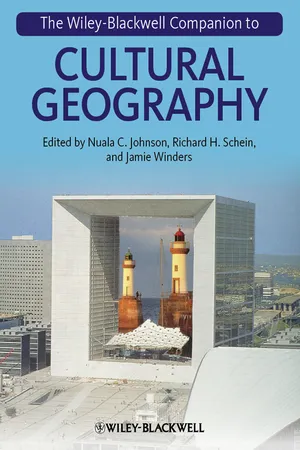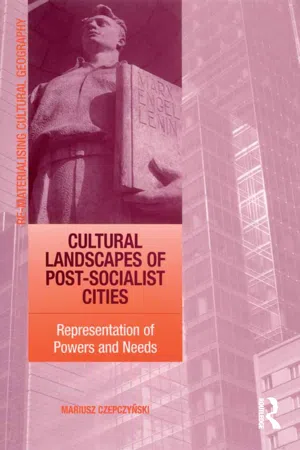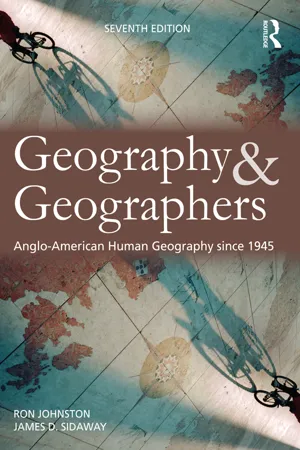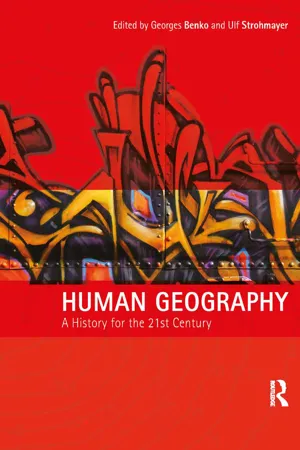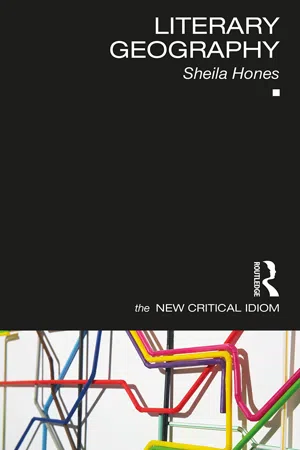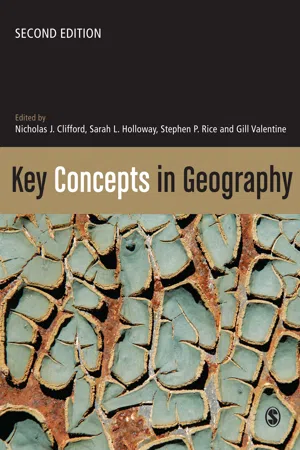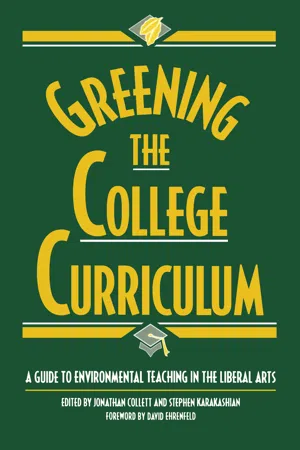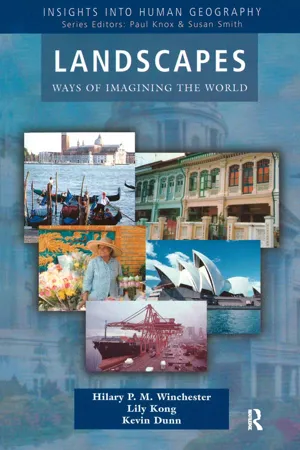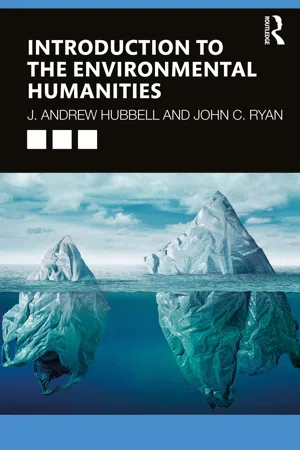Geography
Cultural Geography
Cultural geography is the study of how human culture and society interact with the natural environment. It examines the ways in which people shape and are shaped by their surroundings, including their beliefs, traditions, and practices. This field explores topics such as cultural landscapes, place attachment, and the impact of globalization on local cultures.
Written by Perlego with AI-assistance
Related key terms
Related key terms
1 of 4
Related key terms
1 of 3
12 Key excerpts on "Cultural Geography"
- eBook - ePub
- Nuala C. Johnson, Richard H. Schein, Jamie Winders(Authors)
- 2013(Publication Date)
- Wiley-Blackwell(Publisher)
It is hard to find a key word or topic in Cultural Geography these days that does not enjoy an interdisciplinary constituency. That is a good thing. The contemporary fascination with the “cultural” has generated an enormous body of work on which cultural geographers draw and to which they contribute. Cultural Geography as a subdiscipline brings to the conversations a long tradition, most notably attention to space and place, to the spatiality of everyday life at multiple and fluid scales, to landscapes as the re-suturing of human and physical worlds, and to the politics and epistemological implications of these engagements. In the past decade, these traditional foci have remained intact, even as some have garnered renewed enthusiasm (such as nature–society questions), others have undergone increased conceptual scrutiny (such as the “cultural landscape” concept), and many have engaged new conceptual or theoretical possibilities (such as increased interest in affect and emotion or consideration of the “posthuman”). All of these developments are present in this volume, and this introductory chapter signposts some of these traditional, new, and renewed areas of interest in Cultural Geography and the ways these topics have shifted in the last decade. This chapter is not, however, meant as a comprehensive introduction to the subdiscipline of Cultural Geography. Instead, it is an invitation to examine the field’s ever-changing contours through the ensuing essays.Cultural Geography has been a foundational building block of human geography since the discipline formally was established in the nineteenth century. Documenting spatial patterns in human interaction with, responses to, and transformations of the natural landscape, raising questions about how landscape itself was shaped by and shaped social dynamics, and problematizing the ideas of culture, landscape, and nature have been Cultural Geography’s contributions to the ways that human geographers have thought about the world around them, past and present. Today, the line between human geography as a discipline and Cultural Geography as a subdiscipline is blurred to the point that Cultural Geography is human geography in some corners of our field. Recent intellectual and scholarly developments within geography have drawn cultural geographers closer to the fold and to deeper engagements with colleagues and ideas once thought beyond Cultural Geography’s purview – political, economic, historical, or environmental geography, for example. These connections have been strengthened through Cultural Geography’s embrace of and relevance to the so-called cultural and spatial turns across the human sciences as well as its engagement with social theory and concepts of interest to a broad range of scholars within and beyond the discipline. In short, cultural geographers today study nearly every aspect of human geography and do so in ways that simultaneously reinforce the subdiscipline’s place in geography and question the logic and locations of its boundaries.Cultural Geography is itself deeply geographic in terms of what places and spaces cultural geographers study and how cultural-geographic scholarship is conducted across institutional and national contexts. Although Cultural Geography developed historically and intellectually in relation to other areas of human geography, such as cultural ecology and social geography, it also has developed in relation to its practical and institutional contexts. Cultural Geography means different things in different places and is enacted in different ways, especially between its North American and British variants (see, for example, Audrey Kobayashi’s discussion of this phenomenon in relation to geographic treatments of race in Chapter 9). Where - eBook - ePub
Cultural Landscapes of Post-Socialist Cities
Representation of Powers and Needs
- Mariusz Czepczynski(Author)
- 2016(Publication Date)
- Routledge(Publisher)
New Cultural Geography can then be defined as the study of geographical aspects of human culture as processes and practices of meanings; all possible aspects of different spatial and thematic levels. Based on new and more vibrant and interactive understanding of culture grew humanistic geography or the geography of representations, as a newer aspect of Cultural Geography, where cultural space is wrought on the basis of representation. On this context cultural space is a space of belief in common values structures by ideas or ideologies (see Mitchell 2001, Marcus 2000, Crang 2004). Cosgrove and Jackson’s (1987) concept of new Cultural Geography was raised from criticism of the Berkeley school based on its narrow focus on physical artefacts, as well as a unitary view of culture rather than a constantly negotiated and constituted plurality of cultures. They also argued for a more complex concept of landscape, recognizing it as a cultural construction, a ‘particular way of composing, structuring and giving meaning to an external world whose history has to be understood in relation to the material appropriation of land’ (Cosgrove and Jackson 1987, 96). Landscape has been seen as a social and physical construction, where symbolic and represented landscapes produced and sustained social meanings, visualized in physical forms. In the pursuit of such analyses of landscapes, they highlighted the usefulness of two metaphors: landscape as text and landscape as theatre (see Cosgrove 1998, Cosgrove and Daniels 2004, Kong 2007). Cosgrove and Jackson’s (1987) vision for contemporary Cultural Geography is multi-level and holistic. It would, moreover, assert the centrality of culture in human affairs - eBook - ePub
Geography and Geographers
Anglo-American human geography since 1945
- Ron Johnston, James D. Sidaway(Authors)
- 2015(Publication Date)
- Routledge(Publisher)
By localizing social interaction into discrete cultures … contentious activities are abstracted into the partial truth contained in the idea of culture: namely that there are true and deep differences between people. (p. 109) This strategy is crucial in many aspects of life, such as geopolitics (see p. 264, this book) and the promotion of consumerism; indeed, as the essays in Roger Lee and Jane Wills (1997) illustrate (see also Thrift and Olds, 1996; Wheeler, 2002b), it is increasingly difficult to separate the cultural from the economic. For Don Mitchell (1995), therefore: like ‘race’, ‘culture’ is a social imposition on an unruly world. What does exist, and very importantly, is the historical development of the idea of culture as a means of ordering and defining the world…. Culture is an idea that integrates by dividing … (p. 112) As such, many cultural geographers were deeply involved in developments during the 1990s, characterised in Chapter 7 as ‘the cultural turn’. We return to these issues in Chapter 7. For now, it is sufficient to note that whereas traditional cultural geographers paid little explicit attention to methodological concerns, those linked to the more recent developments addressed a range of issues involved in the collection of ‘data’, through the interrogation of both texts and people’s lived experiences. In this respect, Ian Cook and Mike Crang (1995) equated (a renewed) Cultural Geography with humanistic geography in terms of the methods adopted. There is a sense that one of the preconditions for such renewal, however, was the legacy of human-orientated research in geography which came to the fore in humanistic geography’s critique of positivism and spatial science. ‘Doing humanistic, or cultural, geography’ involves a variety of methods often characterised as ethnographic and contrasted to the positivist approach (Cook and Crang, 1995, p - eBook - ePub
Human Geography
A History for the Twenty-First Century
- Georges Benko, Ulf Strohmayer, Georges Benko, Ulf Strohmayer(Authors)
- 2014(Publication Date)
- Routledge(Publisher)
2 Cultural Geography: place and landscape between continuity and change Paul Claval and J. Nicholas EntrikinGeography has a long history, but human geography was born only in the late nineteenth century, in Germany, with the publication in the 1880s of the first volume of Ratzel’s Anthropogeographie (1881–91). From the outset, culture was thought to be a significant aspect of human geography, but the cultural approach to the discipline was hampered by the dominant naturalist and positivist epistemologies.Geographers held different views of their field. For the majority of them, geography had to explain fundamentally the regional (and local) differentiation of the earth. With the growing influence of evolutionism, the relationship between man and milieu appeared as the most successful challenger of the earlier regional perspective. In order to avoid conflict between the two conceptions, the idea that geography was the science of landscapes began to flourish. It offered a major advantage: a specific field for geographic inquiry.These three conceptions were generally combined: geographers explored the diversity of the earth and prepared maps to show it; they had an interest in the diversity of landscapes, which introduced a large-scale, local component, to their approach; they often focused — either at the global, regional or local level — on man-milieu relationships. Their ambition was to present an objective description of the earth and develop a knowledge of the laws which explained its organization. Generally, they had no interest in the geographical views or interpretations developed by the people they studied. These conceptions evolved, but their epistemological basis remained remarkably stable until the mid-twentieth century. - eBook - ePub
- Sheila Hones(Author)
- 2022(Publication Date)
- Routledge(Publisher)
In the 1990s and early 2000s, the human geography variant of literary geography experienced a period of regeneration corresponding with the rise of what was known at the time as the ‘new Cultural Geography’. The ‘newness’ of this form of Cultural Geography lies in the ways in which the largely UK-based initiative broke from an earlier US-based form of Cultural Geography, developed in the 1920s by Carl Sauer at UCLA Berkeley. Sauerian Cultural Geography focused on distinctive areas ‘fashioned from a natural landscape by a cultural group’, with the natural area providing the medium, and the local way of life (culture) providing the agent, the result being ‘the cultural landscape’. In contrast, the ‘new Cultural Geography’ focused on how ‘cultural differences comprise the human world’.The sense in which … the human world is not distinct from (or at least not independent of) its representations – became a mainstream concern: culture was constitutive, performative, always-already in the making. Despite some outstanding debts to the Berkeley School of Cultural Geography – notably an abiding interest in landscape – the new Cultural Geography owed more to the growth of cultural studies.(Clarke, 2017 : online)The cultural turn
Although the ‘new’ Cultural Geography has sometimes been conflated with a wider ‘cultural turn’ which took place in the humanities and social sciences between the 1970s and the 2000s, the ‘cultural turn’ names a much broader shift in subjects and priorities across the humanities and the social sciences. Broadly speaking, while the cultural turn drew on the work of a wide range of thinkers and theories, it was articulated in the form most significant for geography in the work of Stuart Hall, Paul Gilroy and others at the University of Birmingham’s Centre for Contemporary Cultural Studies (UK). The impact of the cultural turn in geography was arguably most influential not on the development of literary geography or even Cultural Geography in general but in fields such as economic geography and critical geopolitics (Rosati, 2017 : online).The spatial turn
At the same time that the ‘new Cultural Geography’ was being established in the social sciences, an increased interest in space and place in the humanities – sometimes called the ‘spatial turn’ – led to the emergence of a line of spatially-oriented work in literary studies. Leonard Lutwack’s The Role of Place in Literature , for example, which appeared in 1984, referred to ‘a new interest in place both as a formal element in literature’ and ‘as an important issue in general’, resulting from a new ‘public recognition that earth as a place, or the total environment is being radically changed and perhaps rendered uninhabitable’ (2). Lutwack in this way foreshadowed the emergence of ecocriticism and geopoetics, while also having a direct influence on D.C.D. Pocock’s work on literary geography in the UK: he is cited six times in Pocock’s 1988 review article on geography and literature for Progress in Human Geography , in which Pocock mentions that although Lutwack’s work was one of a few hopeful exceptions, in general the literary studies/human geography ‘interface’ had been ‘largely unidirectional’ (Pocock, 1988 - eBook - ePub
- Cynthia Metcalf, Rhonda Atkinson, Rhonda Atkinson(Authors)
- 2017(Publication Date)
- Research & Education Association(Publisher)
The study of culture and Earth interactions is called cultural ecology. Political ecology is a multi-disciplinary study of how social and environmental change occurs in the context of power relations, social structures, economic issues, and human–environment interactions. Humans depend on the environment to provide them with their basic needs: food, shelter, and clothing. Humans also modify that same environment in order to meet their needs. For instance, people build dams to change the way water flows, plow and irrigate fields to grow food, clear forests to build houses, and dig mines for minerals and natural resources that help sustain life. Humans adapt to their environment if they cannot change it. For instance, people put on warm coats and use heaters when they live in cold climates. How people adapt to their environment depends to a large extent on their ability to do so—and it reflects their economic and political circumstances and their technological abilities. Human–environment interaction has also shaped Earth’s physical systems and features. For example, building on oceanfronts may increase erosion and alter the landscape. Clearing forests to make room for agriculture or cities changes the appearance of the landscape. Building dams and canals changes the way water flows. Geographers approach the study of human–environment interaction in a variety of ways: Environmental determinism: This is the view that the environment can overpower people and determine their culture and the direction and extent of their development. This is widely considered a “not politically correct” belief in geography. The main train of thought in environmental determinism is that an area’s physical characteristics, like climate, impact how people develop over time - eBook - ePub
- Nicholas Clifford, Sarah Holloway, Stephen P Rice, Gill Valentine, Nicholas Clifford, Sarah Holloway, Stephen P Rice, Gill Valentine(Authors)
- 2008(Publication Date)
- SAGE Publications Ltd(Publisher)
Chapter 4 for a discussion of geography and the humanities). This work ranges over many aspects of behaviour, including the micro-scale of the individual body, seeking to understand the meanings that underpin actions – many of which are never recorded during the processes of everyday life. The relationships between people and nature are also being reconsidered, breaking down the perceived artificial boundaries between these long-considered binary opposites (Whatmore, 2002). Here again, new approaches are being explored for the interrogation of actions, including places as their arena. Indeed, such is the geographical contribution to cultural studies that some identify a ‘spatial turn’ within the humanities (Anderson et al., 2002); other geographers continue to explore the interactions between humans and their environment in more ‘traditional’ ways (Turner, 2002).CONCLUSIONS: HUMAN GEOGRAPHY – SOCIAL SCIENCE AT LAST
Geography came late to the social sciences, therefore, and by the time that human geographers sought to ally with them they found they were excluded. In response, while remaking their own discipline they also had to make strong claims that it was now clearly a social science. To do this, they initially emphasized a particular aspect of the social sciences, privileging economic over other forces as determinants of human behaviour, and emphasizing models of spatial behaviour – of organization and flows – in which those forces dominated. They achieved some success in this strategy. A stream of work was introduced which remains strong, although it has changed over the last four decades. Rigorous analysis of quantitative data remains at the core of what is known as the spatial analysis tradition (Johnston, 2003b; Fotheringham, 2006). Formal models based on idealized spatial patterns derived from oversimplified principles have largely been jettisoned, however, though interestingly they were taken up by a school of economists in the 1990s, in a ‘new economic geography’ which geographers (with some exceptions) claim they disowned 20 years ago (Clark et al., 2000); the two ‘strands’ are being brought together through a journal – Journal of Economic Geography - No longer available |Learn more
- Meredith Marsh, Peter S. Alagona(Authors)
- 2023(Publication Date)
- Barrons Educational Services(Publisher)
Human geography is the study of human activities on Earth’s surface. Since the first scholars began studying geography some 3,000 years ago, the field has matured into an important and wide-ranging area of academic and applied research. One thing that binds all geographers together is the spatial perspective. Looking at Earth from a spatial perspective means looking at how objects, processes, and patterns change over the earth’s surface. Geographers describe these variations by creating visual representations of spatial data in the form of maps. All maps are based on a projection. They have a characteristic scale and resolution. All maps use symbols to depict spatial information. Geographers use a diverse set of concepts, tools, technologies, and mathematical equations to study places, regions, and the processes that link them. In general, places that are closer to each other in absolute distance tend to interact more. However, the interaction among places is also determined by the size of each place, their level of connectivity, and the diffusion processes that carry information and cultural traditions from one place to another.End-of-Chapter Practice
Geography as a Field of Inquiry
Multiple-Choice
1.Human-induced environmental change is often referred to as (A)anthropomorphic. (B)anthropocentric. (C)anthropogenic. (D)unsustainable. (E)environmental determinism. 2.Conserving resources to ensure enough for future generations is called (A)subsistence agriculture. (B)sustainability. (C)cultural ecology. (D)environmental determinism. (E)the organic movement. 3.______________ argued that cultural landscapes should form the basic unit of geographic inquiry. (A)Ptolemy (B)George Perkins Marsh (C)Eratosthenes (D)Carl Sauer (E)W. D. Pattison - eBook - ePub
- Tim Unwin(Author)
- 2013(Publication Date)
- Routledge(Publisher)
HAPTER 8The place of geographySince antiquity geographers have explored and analysed the earth's surface from two related perspectives: that of the spatial differentiation and associa tion of phenomena with an emphasis on the meaning of space, spatial relations and place; and that of the relationship between man and his physical environment. The two are closely related because the meanings of space and place depend on the interrelationships among physical and human activities located in space, and man's relationships to the environment occur in the context of space and place.(Sack, 1980: 3)One of the most salient characteristics of geographical practice in the last twenty years is that geographers have increasingly accepted the inherent diversity of the discipline and have in general ceased trying to identify a single core to the discipline. Rarely are arguments today promulgated to suggest that the central aim of geographical enquiry is, for example, to create a spatial science, or that systems analysis forms a unifying methodology for the discipline. Some, moreover, have argued that 'there is no need for geography and the other presently constituted fragments of social science, since they must be rejected' (Eliot Hurst, 1985: 60). In particular, this period has been characterized by an increasing division between the human and physical sides of the discipline. Stoddart (1987a: 330) has eloquently described this situation as follows:The result is clear enough. Across geography we speak separate languages, do very different things. Many have abandoned the possibility of communicating with colleagues working not only in the same titular discipline but also in the same department. The human geographers think their physical colleagues philosophically naive; the physical geographers think the human geographers lacking in rigour. Geography - Forster's, Humboldt's, Mackinder's - is abandoned and forgotten. And inevitably we teach our students likewise. Small wonder that the world at large wonders what we are about. - eBook - ePub
Greening the College Curriculum
A Guide To Environmental Teaching In The Liberal Arts
- Jonathan Collett, Stephen Karakashian, Jonathan Collett, Stephen Karakashian(Authors)
- 2013(Publication Date)
- Island Press(Publisher)
Under the rubric of environmental perception, geographers address conservation, environmental ethics, and resource management by revealing cultural attitudes to wilderness and wilderness preservation. These perceptions are shaped by religious tradition and socioeconomic conditions (Doughty 1981; Graber 1976; Tuan 1971; Tuan 1974). Human awareness of and experience with natural hazards, for example, vary considerably among different groups of people at local, national, and global levels, hampering the degree to which people can effectively cope with such calamities (Palm 1990).In the field of cultural ecology, geographers examine human interaction with their environment through the process of adaptation. Their studies of subsistence systems in rural areas of developing countries reveal that many aboriginal and peasant societies possess a wealth of information regarding their biophysical surroundings, which enables them to manage local resources in a manner favoring long-term ecological stability (e.g., Brower 1990; Grossman 1984; Nietschmann 1973). Findings from these studies have been used to promote new models of development and conservation that incorporate ecologically sound resource management practices from local groups (e.g., Clarke 1977; Denevan 1980).The political ecology approach evolved out of earlier works in cultural ecology, broadening the focus to explore interactions between local land use and political and economic institutions at regional, state, and international levels (Blaikie and Brookfield 1987; Bryant 1992). For example, Watts (1983) combines environmental and political economy approaches to analyze peasant food production, famine, and desertification in Nigeria. Most of these studies emphasize agricultural systems. Less well studied are the dimensions of human use of terrestrial and marine fauna and whether human activities are compatible with the long-term survival of these biological resources.Environmental Processes and Resources
Geographers who study biogeography, climatology, and geomorphology are distinguished from their colleagues in other natural sciences by their scale of inquiry and their attention to human agency in modifying or altering environmental processes. An introductory course in biogeography will help students understand the relationship between abiotic and biotic elements in the landscape as well as human impact on vegetation (Veblen 1989). Since biogeographers record and explain changing patterns of floral and faunal assemblages across space and time (Veblen 1989), their work is important to the selection of priority areas for protection. Biogeographers provide an alternative to the single species approach to biodiversity conservation, as they are likely to focus on higher taxa or communities at regional scales (Gunderson et al. 1995; Veblen et al. 1992). Biogeography research often explores patterns of vegetation disturbance and succession under varying degrees of human influence, while also documenting the consequences of human-introduced species (Parsons 1972). - eBook - ePub
Landscapes
Ways of Imagining the World
- Hilary P.M. Winchester(Author)
- 2013(Publication Date)
- Routledge(Publisher)
Change in the landscape will equate with change in culture and vice versa. Landscape change can lag behind cultural change. A major transformation in the cultural look of the landscape is indicative of a major change in culture New tastes in cuisine and the entry of new cultures through migration will manifest spatially. Social disharmony and exclusion will manifest as segregation (see Figure 5.4 ) 2 Cultural landscape equality No specific landscape feature or cultural manifestation of a group is necessarily more or less important than another, better or worse The McDonald's Family Restaurant is as instructive to geographers as an artefact of culture; so is the Eiffel Tower 3 Everyday landscape of common things The ordinary landscape has been little researched. Researchers have been dismissive or disparaging of such common things. If studied with care and without elitism they can tell us a great deal about everyday culture The rapid spread of McDonald's Family Restaurants (see Figure 2.2 ) through Australia is reflective of the uptake of American popular culture, as ate the everyday shop fronts within malls 4 History and landscape To read a landscape properly a researcher needs to know something of the history of a place To interpret graffiti and murals in Belfast properly, one needs to know about sectarianism in Belfast, the Troubles and the historical development of Ireland, especially the north (see Figures 5.3 and 5.5 ) 5 Geographic context A landscape or landscape feature can only be understood with reference to the surrounding places and landscapes A reading of the city of Newcastle (see Figure 2.3 ) should bring an awareness of nearby coalfields and the nearby presence of a navigable port 6 Physical landscape The human landscape is related to the biophysical environment. Aspects such as terrain, climate and geology can be important The tiver, timber and the presence of coal deposits help explain the location and morphology of Newcastle (see Figure 2.3 ) 7 Landscape obscurity The landscape does not speak to us very clearly. Primary messages can be deceiving. Cultural geographers need to ask the right questions and look the right way - eBook - ePub
- J. Andrew Hubbell, John C. Ryan(Authors)
- 2021(Publication Date)
- Routledge(Publisher)
GeoHumanities: Art, History, Text at the Edge of Place. London: Routledge. This trailblazing work explores the potential of the geohumanities through sections on creative places, spatial literacies, visual geographies, and spatial histories. The editors develop four key terms—geocreativity, geotext, geoimagery, and geohistory—of high interest to researchers at the junction of geography and the humanities.- Duncan, James S., Nuala C. Johnson, and Richard H. Schein, eds. 2008. A Companion to Cultural Geography. Hoboken: Blackwell Publishing. This edited collection featuring contributions from leading scholars in Cultural Geography provides a concise introduction to key theories, approaches, and frameworks such as historical materialism, feminisms, poststructuralism, psychoanalytic approaches, performativity, nationalism, social class, sexuality, public memory, and transnationalism.
- Kopnina, Helen, and Eleanor Shoreman-Ouimet, eds. 2017. Routledge Handbook of Environmental Anthropology. London: Routledge. This valuable introduction to current trends in this rapidly diversifying field includes sections on the development of environmental anthropology; the new sub-fields of enviromateriality, historical ecology, architectural anthropology, and relational ecology; ecological knowledge, belief, and sustainability; climate change, resilience, and vulnerability; justice, ethics, and governance; health, population, and environment; and environment and education.
- Relph, Edward C. 1976. Place and Placelessness. London: Pion. Published over four decades ago, Canadian geographer Edward Relph’s landmark study is a phenomenological analysis of human experience of place. Articulating the importance of sense of place, the book postulates that the idea of place is rapidly changing as a result of climate change and economic disparities.
- Seddon, George. 1972. Sense of Place: A Response to an Environment, the Swan Coastal Plain, Western Australia
Index pages curate the most relevant extracts from our library of academic textbooks. They’ve been created using an in-house natural language model (NLM), each adding context and meaning to key research topics.
Explore more topic indexes
Explore more topic indexes
1 of 6
Explore more topic indexes
1 of 4
